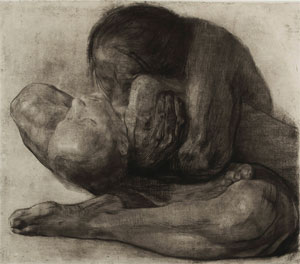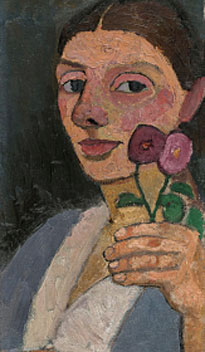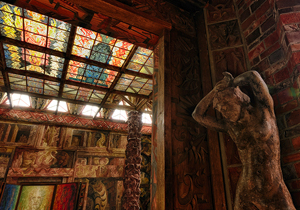A Woman's Rise and Fall
John Haberin New York City
Käthe Kollwitz and Paula Modersohn-Becker
Johann Bossard, German Expressionism, and the Nazis
Käthe Kollwitz started her career with death and ended with love. It could just as easily have gone the other way around.
Her first print series, from the 1890s, follows a worker's revolt from its beginnings in Need and Death. This is A Weaver's Revolt in Silesia, industrial country, where workers knew need and death well. A march that should be a triumph of solidarity and action looks more like a forced march, the workers hunched forward in weariness. And then comes simply End, with bodies on cots and the living barely set off from the darkness, pondering what has happened and what is to come. Her art at MoMA comes down to the rise and fall of dignity and democracy.  She knows, though, where she stands and how much she has loved.
She knows, though, where she stands and how much she has loved.
"Ich bin Ich," and of course she was, but Paula Modersohn-Becker had her doubts about herself. The Neue Galerie takes the title of her retrospective from a letter to Rainer Maria Rilke, and it rings true for today. I, a woman, am myself and no one else, she wrote, a boast for many a woman artist now—but who am I? She had just left her husband, Otto, restless for answers. She could not go back to the younger artist she had left behind, but what was the way ahead? She had every right to ask, and she died at just thirty-one, on the brink of a new art form for a new century.
Was German Expressionism in solidarity with them both? Did it represent the anxiety of a nation or a privileged class? An accidental discovery could be claimed for either side. The evidence lay on plain view. Starting in 1911, a Swiss artist dedicated his life to a plot of land in Lower Saxony and a vision of expressionist art. The result was a museum out of one's wildest imaginings or persistent nightmares.
It may also contain a swastika, right in the floor tiles, where it will not go away without a fight. Does that invalidate the artist's legacy—or the museum itself? Had he left behind a monument to Nazism or an act of rebellion? Is the shape even a swastika? If so, Johann Bossard put it there. It has become a point of contention over the politics of Modernism all over again.
The end of love
Each series by Käthe Kollwitz has the same arc of death and love. Peasants' War from 1902 to 1908 looks to the sixteenth century for models, and it finds one in a woman sharpening a scythe. It, too, ends in violent suppression. A third series, just after World War I, testifies to the costs of war. Titles speak of Mothers, The People, and Survivors, but not as heroes. Rows of women and children look formidable in their grief.
Kollwitz felt the arc of rise and fall personally. Born in 1867 in East Prussia (parts of today's Russia and Poland), she moved to Berlin in her twenties with her husband, a physician who saw to the poor. She learned grief from his patients. Quickly acclaimed, she would have won a gold medal at the Berlin Art Exhibition had not the Kaiser himself stepped in. An award to a leftist and a woman would have gone too far. Still, war's end made Germany a republic—and made her a professor at the Prussian Academy, its first woman.
Yet the arc had not finished with her, not by any means. She lost her younger son in the Great War, and the elder almost died from diphtheria. She lost her teaching position and freedom to exhibit to the Nazi rise to power. She died just weeks before their fall. It seems only right that MoMA hangs A Weaver's Revolt from left to right, so that one encounters first its end. Still, she had found her purpose as an artist in insisting on the purposiveness of art.
Kollwitz took to paper because of that purpose. Prints to her meant multiples, to reach the people, like poster art to this day. It also allowed her to rework her art with a record of every stage. She combines woodcuts, etching, lithography, and drypoint, enhanced with sandpaper—and then overlays prints with whatever comes to hand. Her drawings could pass for series, too, as she begins again and again. If there is a progression from start to finished product, it eludes me.
She never lets go of a theme either, like revolts and state violence. That includes her most titanic drawings, of a mother with dead child. That woman holding a scythe has almost the exact same pose, but with a sharp object in place of a child. By the show's end, she has taken up sculpture, and the pose has become first lovers after Auguste Rodin and, at last, a mother protecting her child from death as the ultimate act of love. It involves the same confusion of hands and limbs. It looks back to a Renaissance Pietà and the contortions of Mannerism—but then she was an academic, and other deaths recall a Dead Christ.
The curators, Starr Figura with Maggie Hire, open with self-portraits as an extended prologue, but they, too, recur often. Kollwitz betrays neither fear nor certainty, her cross-hatching touched by washes and highlights, like the shine on her forehead. By the show's end, she has documented aging with unflinching realism. She belongs to the first wave of German Expressionism, but without the gilded flattening of Gustav Klimt or the swollen, exaggerated hands of Oskar Kokoschka. She responds to World War I much like Max Beckmann, but not to satirize Berlin high society. She was never, for all her greatness, a revolutionary in her art, but she still has her arc and her archetypes of the people.
Who am I?
How did German Expressionism arise in the first place? In her painfully brief career, Paula Modersohn-Becker offers a snapshot of a crucial moment. She died of complications from childbirth (an embolism) in 1907, the very year of the museum's most prized work, the woman in gold by Klimt. Almost its entire collection lay ahead. She had joined Worpswede, an artist colony not too far from her family home in Bremen, and studied in Berlin, with classical training in drawing from life. In repeated trips to Paris, she took in the latest exhibitions, but even more so the Louvre.
She admired Fauvism, but Henri Matisse and André Derain had returned from their summer by the sea barely a year before. Pablo Picasso was still a newcomer to Paris in Montmartre. Modersohn-Becker did not live to see World War I, which did so much to shape Max Beckmann,  or the postwar decadence, turmoil and experiment that Hitler denounced as "degenerate art." Everything for her was figure painting, even when it includes still life, and she was determined to make it modern. She left her own version of Klimt's standing woman, with a similarly patterned backdrop, but she made it hers twice over, without the gold. It shows her and her alone, naked and pregnant.
or the postwar decadence, turmoil and experiment that Hitler denounced as "degenerate art." Everything for her was figure painting, even when it includes still life, and she was determined to make it modern. She left her own version of Klimt's standing woman, with a similarly patterned backdrop, but she made it hers twice over, without the gold. It shows her and her alone, naked and pregnant.
She was painting affection, but with a frankness born of detachment and reserve. She paints herself repeatedly, in one case with a blank face. That self-portrait could be unfinished, but, hey, you never know. Often she holds up a flower, like a shield, because she deserves no less but can afford little more. She paints a mother and child, fleshy and caring, but neither friend, nor family, nor herself. She did reunite with Otto and give birth to a daughter, but the show's only portrait of him, years earlier, brings him so close to the picture plane that his limbs become fragments.
Still, it an act of love, take it or leave it. At the very least, it is an act of respect from one artist to another. A room for work from just before 1890 accords peasants and workers that same respect. It also shows the discipline of classical drawing, in charcoal with bare accents of color, and what she had soon to give up. Her early subjects have distinct personalities, but modernizing for her soon meant something else again. From that point on, faces let on only discomfort at having to pose.
She begins taking things apart while building up flesh and paint to match. She also turns to children, they, too, cautiously holding flowers. She treasures those accents of color, which increasingly give a painting its focus. Still, she never fully gets over her muter early work. She may have liked Fauvism, but she prized Paul Gauguin more. She uses patches of brown much like his for shadows, to structure a figure and a painting.
In so short a career, it is hard to speak of artistic development, although Modersohn-Becker left behind more than seven hundred paintings and a thousand drawings. The show spans barely a decade, with no examples of her earliest work back in Bremen. (That work does allow the color clashes of Post-Impressionism.) She never did become the pioneering artist confident in her Ich and I. It does, though, leave her on the brink of something to come. Could that something be German Expressionism?
Expressionist or Nazi?
Johann Bossard designed the three buildings, the paintings, the sculpture, and, with his wife, Jutta Kroll-Bossard, the garden. Known today as Kunststätte Bossard, it lives up to Richard Wagner's boast in opera of a Gesamtkunstwerk, or total work of art. One can see Bossard's hand and his agonies in a man with tears in his eyes, a beast in the pit of his stomach, and a fire in his groin. One can see them in garden statues after Michelangelo. The latter created his Slaves for the tomb of a pope, and the entire museum can feel like a page out of history. If so, it is a wild one.
The architecture has the quaint look of a rural chalet, but with carvings and paintings everywhere. Murals present waves or storms of color, churning in an uncertain depth while spilling out from the walls and ceiling into the space of the viewer. The intricate floor patterns shift dramatically within inches— and there in 2017 a staffer preparing a program for children spotted the swastika. The museum acted responsibly, using it as the occasion for reflection and education. An exhibition and book laid out Bossard's ties to Nazi Germany, such as they were, and his interest in folk traditions like, say, a swastika. It was not enough.
and there in 2017 a staffer preparing a program for children spotted the swastika. The museum acted responsibly, using it as the occasion for reflection and education. An exhibition and book laid out Bossard's ties to Nazi Germany, such as they were, and his interest in folk traditions like, say, a swastika. It was not enough.
Others since have pounced. Der Spiegel, the German equivalent of Time, complained of "Tax Money for the Swastika," and politicians agreed. The controversy reached The New York Times. Bossard, it explained, spoke in favor of the Nazis, if not for long, but never joined the party. He went along with a group of Nazi educators, but soon quit. He may well have done the minimum to survive, especially as a champion of what Hitler dismissed as degenerate.
Was the swastika a gesture to the same end? I am unlikely to find out in person—and not just because the offending image is, for now, under a rug. The museum is a healthy day trip from Hamburg to the north, itself hardly an arts or tourist destination. Still, I had to stare at a photo long, hard, and often before I made out the pattern. Then, too, Bossard died in 1950 and his wife in the 1990s, after decades of managing the institution and promoting their work. If that is the most incendiary of symbols, in a country that has banned its display, could no one have seen it before?
I have trouble seeing Bossard as a cryto-Nazi or, alternatively, a closet subversive. To my mind, if he had meant either one, he would have given it pride of place. Instead, it lay trampled unobserved and underfoot. Attentive to every detail, he would also made it more of a swastika. If you think of one as four L-shapes but with the foot of the L as long as its tail, here the foot stops short. Just one more short tile to every side could have extended it.
The Times reports on controversies; it does not adjudicate them (a continuing gift to Donald J. Trump). One might wonder at the motives of others as well. Who can resist complaining about funding for the arts—and what curator can resist a shocking discovery? The museum's director, Heike Duisberg-Schleier, notes wryly that Neo-Nazis "are not our target demographic," but could conceding the discovery make them more likely to come? For now, I can only admire all sides for their honest confrontation with the past, and I can only identify with a Holocaust survivor who has made it a personal issue. Yet the wildness remains, far from the Nazi dream of a purer nation.

Käthe Kollwitz ran at The Museum of Modern Art through July 20, 2024, Paula Modersohn-Becker at the Neue Galerie through September 9. The New York Times reported the story of a swastika on August 11, 2020.




